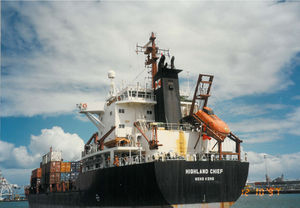Highland Chief
Sister of the ship Chekiang III
Contents
History
March 1990. Delivered to China Navigation Co. as Highland Chief.
1999. Placed on charter, renamed Forum Tonga
2001. Renamed "Highland Chief", later became Kiribati Chief
March 2005. Lengthened by Miho Zosen, Shimizu. Specifications as in Images.
Service
Events / Stories
"HIGHLAND CHIEF" was the lead ship of the class of five built for CNCO at Miho in the period 1989-91 and known as the "Miho Mark Twos", the "Mark Ones" having been the "PAPUAN CHIEF"II, "CORAL CHIEF"II, "CHENGTU"III and "NIMOS".
CNCo had not ordered a newbuilding since the "HUPEH"; an experience that was not considered entirely satisfactory. Consequently a great deal of care was taken to get these ships "right".
The design concept originated with John Milward, who, during a spell in command of the "POLYNESIA", spent his speare time drawing up his ideas for a replacement "POLY 2" incorporating more up to date ideas. His drawings and outline spec. were circulated round the office and attracted a lot of favourable comment, but the Polynesia Line trade could not support a newbuilding, so nothing was done until NGAL, in the person of Edward Scott, let it be known that they thought it was high time they had a new ship, and told CNCo to get on with it.
Using Captain Milward's sketches and outline spec, an enquiry was circulated to shipyards. This was educational in itself; several yards did not respond because we had gone to them direct and they were accustomed to dealing with brokers - we had to tell them who we were and that we were serious.
We did not include Miho in the initial circulation because we knew that their slipway was constrained and the ship we wanted would be too long for them. Several proposals were receieved including one from British Shipbuilders, who as usual submitted an excellent design, but their price was well outside what CNCo could afford.
At this point we receieved a phone call from Ken Kobayashi of Mitsubishi Corporation; he wanted to come to see us, and he did, bringing with him the senior staff of Miho who assured us that, thanks to a little ingenuity, they could not only build the ship we wanted but could and would tender competitively for her.
Being a Mitsubishi Group company, Miho proposed a Mitsubishi-UEC main engine; this did not meet with our approval and we insisted on a Mitsui-B&W, making these ships some of the very few Mitsubishi ships with Mitsui engines.
Rescue at Sea
Highland Chief was leaving Honaira on 16th June 2013 when the bridge duty officer spotted the faint outline of a life raft on the water. The Man Overboard alarm was sounded and the rescue operation immediately swung into action.
The six people rescued were the crew of Global Lestary, a 146 GRT landing craft, operating under the Solomon Islands flag. Their vessel was carrying logs from Isabel Province to Honiara, when it got caught in bad weather, started taking in water and subsequently listed, with logs falling overboard. The crew had to abandon their vessel, which quickly capsized and sank, and take to the six-man life raft.
The survivors had been drifting at sea for seven days and ran out of drinking water two days before being rescued. Their attempts at attracting the attentions of a passing ferry and tanker using the the vessel's distress flares failed and there was no other means of calling for help. Morale was extremely low and the crew were losing hope when they saw Highland Chief approaching. Once on board, the ship's crew took good care of the rescued seamen and they were returned safely to Honiara. Surprisingly, all six men survived the ordeal without any serious health issues and were extremely grateful to all on board Highland Chief for saving their lives.




